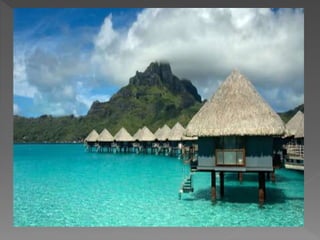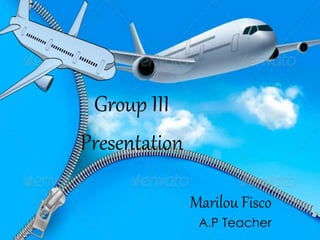Melanesia is a subregion of Oceania located in the western Pacific Ocean. It includes the countries of Fiji, Papua New Guinea, Solomon Islands, Vanuatu, as well as New Caledonia which is a French territory. The region also includes West Papua which is part of Indonesia. Melanesia is home to over 1,000 languages and was first defined by French explorer Dumont d'Urville in 1832 based on the physical characteristics of the inhabitants.
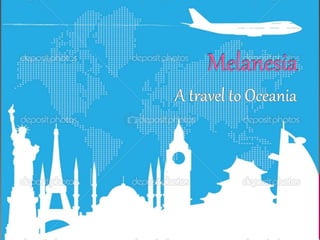
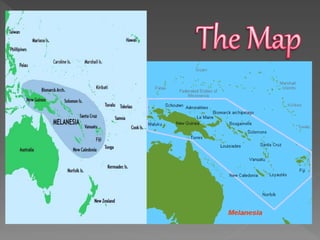






![ The concept among Europeans of
Melanesia as a distinct area evolved
gradually over time as their expeditions
mapped and explored the Pacific.
Early European explorers noted the
physical differences among various
groups of Pacific Islanders. In
1756 Charles de Brosses theorized that
there was an 'old black race' in the
Pacific who were conquered or
defeated by the peoples of what is
now called Polynesia, whom he
distinguished as having lighter skin.[1]:189–
190 By 1825Jean Baptiste Bory de Saint-
Vincent developed a more elaborate,
15-race model of human diversity.[2] He
described the inhabitants of modern-day
Melanesia asMélaniens, a distinct
racial group from
the Australian and Neptunian (i.e.
Polynesian) races surrounding
them.[1]:178.
In 1832 Dumont D'Urville expanded and simplified
much of this earlier work. He classified the peoples
of Oceania into four racial groups: Malaysians,
Polynesians, Micronesians, and
Melanesians.[3] :165 D'Urville's model differed from
that of Bory de Saint-Vincent as he referred to
'Melanesians' rather than 'Mélaniens.'](https://image.slidesharecdn.com/melanesia-141110000145-conversion-gate01/85/Melanesia-9-320.jpg)
![ Although Bory de Saint-Vincent had distinguished Mélaniens
from the indigenous Australians (now known as Aborigines),
Dumont D'Urville combined the two peoples into one group.
He thought 'Melanesia' included Australia, in addition to the
countries which today constitute Melanesia. Dumont
D'Urville's concept of Melanesia was not geographic or
cultural—it was based on classification according to visible
physical characteristics, which he called "race." He described
Melanesia as "the home of the black race of
Oceania."[3] :165 He wrote,
"all the nations of this major division of Oceania are more or
less black in colour, with curly, fuzzy or sometimes nearly
woolly hair, flat noses, wide mouths and unpleasant features,
and their limbs are often very frail and seldom well shaped...
Their aptitudes and their intelligence are also generally
largely inferior to those of the copper-skinned race](https://image.slidesharecdn.com/melanesia-141110000145-conversion-gate01/85/Melanesia-10-320.jpg)
![ The first settlers of Australia, New
Guinea, and the large islands just to
the east arrived between 50,000 and
30,000 years ago,
when Neanderthals still roamed
Europe.”[8] The original inhabitants of
the group of islands now named
Melanesia were likely the ancestors of
the present-day Papuan-speaking
people. Migrating from Southeast Asia,
they appear to have occupied these
islands as far east as the main islands in
the Solomon Islands,
including Makira and possibly the
smaller islands farther to the east.[9]
Melanesians of some islands are one of
the few non-European peoples, and
the only dark-skinned group of people
outside Australia, known to have blond
hair.
Particularly along the north coast of
New Guinea and in the islands north
and east of New Guinea,
the Austronesian people, who had
migrated into the area somewhat
more than 3,000 years ago,[8] came
into contact with these pre-existing
populations of Papuan-speaking
peoples. In the late 20th century, some
scholars theorized a long period of
interaction, which resulted in many
complex changes in genetics,
languages, and culture among the
peoples.[10] Kayser, et al. proposed
that, from this area, a very small group
of people (speaking an Austronesian
language) departed to the east to
become the forebears of
the Polynesian people](https://image.slidesharecdn.com/melanesia-141110000145-conversion-gate01/85/Melanesia-11-320.jpg)

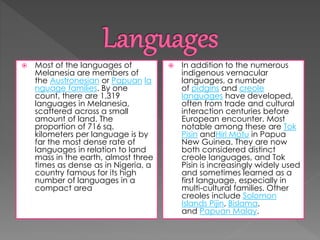
![ A distinction is often made between
the islands of New Guinea and what is
known as Island Melanesia, which
consists of "the chain of archipelagos,
islands, atolls, and reefs forming the
outer bounds of the sheltered oval-shaped
coral sea"[15]:5. This includes
the Louisiade archipelago (part
of Papua New Guinea, the Bismarck
Archipelago (part of Papua New
Guinea andSolomon Islands), and
the Santa Cruz Islands (part of the
country called Solomon Islands). The
country of Vanuatu is composed of the
New Hebrides island chain (and in the
past 'New Hebrides' has also been the
name of the political unit located on
the islands). New Caledonia is
composed of a single large island and
several smaller chains, including
the Loyalty Islands. The nation of Fiji is
composed of two main islands, Viti
Levu and Vanua Levu, as well as series
of smaller islands, including the Lau
islands.
In addition to the islands mentioned
here, there are numerous smaller
islands and atolls in this area. These
include
Amphlett Islands, Papua New Guinea
d'Entrecasteaux Islands, Papua New
Guinea
Maluku Islands
Norfolk Island, Australia (geographically
only)
Raja Ampat Islands
Rotuma, Fiji
Schouten Islands
Torres Strait Islands, politically divided
between Australia and Papua New
Guinea
Trobriand Islands, Papua New Guinea
Woodlark Island, Papua New Guinea](https://image.slidesharecdn.com/melanesia-141110000145-conversion-gate01/85/Melanesia-14-320.jpg)
![ The following countries are
considered part of Melanesia:
Fiji
Papua New Guinea
Solomon Islands
Vanuatu
Melanesia also includes one
dependency of France
New Caledonia
West Papua - The western half of
the island of New Guinea (West
Papua (region) is politically part of
the nation state of Indonesia.
Europeans have always
recognized it as geographically
part of Melanesia. A strong
independence movement,
the Free Papua Movement, is
active in this area.[citation needed]
South Maluku - A group of islands
claim the southern part of
the Moluccas (incl. the Aru
Islands and the Kai Islands). Its
government is currently in exile in
the Netherlands.](https://image.slidesharecdn.com/melanesia-141110000145-conversion-gate01/85/Melanesia-15-320.jpg)


